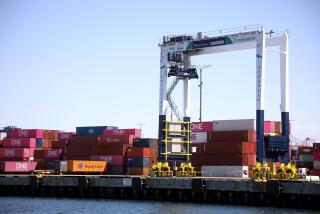As stations go under, filling up becomes a tankful of trouble : EPA predicts nearly half of the nation’s outlets will close rather than meet new rules. Drivers in some rural towns have no place to gas up.
- Share via
CUSICK, Wash. — Checking oil and washing windshields went the way of the Model-T at most service stations a few years back. Now, gas stations themselves are vanishing at an alarming rate across much of the country, especially in small rural towns, leaving motorists with no place to fill up.
“I feel lousy, a lot of people depended on me,” said Les Cole, who ran Cusick’s last gas station for 11 years until he pulled out his pumps and tanks in October.
Gerald Phillips, chief of the Environmental Protection Agency’s underground gasoline tank storage program in the six-state upper Midwest region, said: “I heard from a marketer who said people in one town in northern Minnesota had to drive 50 miles to get gas. The distances are not as great, but there are similar circumstances in northern Michigan and northern Wisconsin.”
New EPA regulations to protect ground water forced most of the recent closings, say gas station operators, their trade organization leaders and state officials.
Indeed, the EPA itself has predicted that nearly 50% of all retail gasoline outlets eventually will close rather than spend large sums to comply with the new rules mandating liability insurance, leak-detection systems, anti-corrosive tanks and other changes.
In Cusick, population 236, Cole researched his costs to comply, balanced them against his existing overhead and $27,000 gross annual revenue from gas sales--and threw in the grease rag. He said his yearly premium for the required minimum $1 million in insurance coverage would run $8,500 and three new tanks would cost about $125,000.
Another operator, Gerry Bradbury in Old Town, Ida., said: “When you’re only making 5 to 10 cents a gallon, you gotta pump a lot of gallons to pay back $80,000.”
Bradbury, in business for 20 years, pulled his pumps, too.
Neither the EPA nor state agencies can say exactly how many stations have closed due to the new EPA standards, which are being phased in through 1998. But evidence abounds that stations, already pressured by other economic factors, are closing in droves.
EPA officials in much of the country, like Phillips in the Midwest, acknowledge that hordes of stations are giving up. “We’ve lost hundreds, if not thousands, in our region,” said Joan Cabreza, whose EPA region covers Washington, Idaho, Oregon and Alaska.
The EPA’s coordinator in Atlanta, John Mason, says the same. The Northeast is showing perhaps the least impact because many marginal stations closed in the early and mid-1980s, when states there enacted similar laws before the EPA’s.
In Washington state, 548 gas stations--20% of all gas retailers--have shut down in the last 18 months as various EPA compliance deadlines have expired, says Tim Hamilton, a lobbyist and director of a large service station group.
Dun & Bradstreet, the Wall Street investment rating firm, reported in March that gasoline outlets led all retailers in closures and bankruptcies, increasing by 79% since 1989.
The closings are more punctuated in sprawling rural Western states, where towns are more isolated and motorists have to drive even farther to get gas.
The disappearance of many stations also portends the demise of another slice of small-town America: the filling station as hub for gossip, soda pop and just hanging around, as well as gas and repair service.
Yet it also will cut deeply into the fragile economy of small communities, some fear.
“A gas station in a small rural town is the anchor retail enterprise for the community,” wrote Don Watson, a planner whose study of the EPA’s rules found that 72% of Idaho’s gas stations are at risk of closing. “If the tourist stops in town to buy gas, there is a higher probability of that person patronizing adjacent retail and service establishments, the arts and crafts shop, the restaurant or the grocery store.”
State governments are hastily creating insurance funds, low-interest loan programs, grants and other plans to make compliance with the EPA rules affordable to station operators. Many of the state programs, however, are not ready, are underfunded or have not been tested by the exorbitant expense of cleaning up an underground gasoline spill. For example, Idaho’s new insurance program, highly touted by state and EPA officials, took three years to develop and has yet to insure a single station. Some wonder if its current $7-million kitty will be enough to pay for cleaning up a few spills.
Meanwhile, one of the EPA’s most critical requirements--that small stations obtain at least $1 million in liability coverage--is nearing its October deadline and another wave of closures is expected.
And insurance--even low-cost state insurance--is not easy to come by because many stations have to clean up even minor leaks before qualifying for coverage. The EPA says “hundreds of thousands” of the country’s 2 million underground tanks are leaking.
“They can’t get insurance without upgrading (leak prevention), they can’t upgrade without a bank loan and they can’t get a loan without insurance,” says the EPA’s Cabreza.
More to Read
Sign up for Essential California
The most important California stories and recommendations in your inbox every morning.
You may occasionally receive promotional content from the Los Angeles Times.













